Connect to and manage erwin Mart servers in Microsoft Purview
This article outlines how to register erwin Mart servers, and how to authenticate and interact with erwin Mart Servers in Microsoft Purview. For more information about Microsoft Purview, read the introductory article.
Supported capabilities
| Metadata Extraction | Full Scan | Incremental Scan | Scoped Scan | Classification | Labeling | Access Policy | Lineage | Data Sharing | Live view |
|---|---|---|---|---|---|---|---|---|---|
| Yes | Yes | No | Yes | No | No | No | Yes | No | No |
The supported erwin Mart versions are 9.x to 2021.
When scanning erwin Mart source, Microsoft Purview supports:
Extracting technical metadata including:
- Mart
- Libraries
- Models
- Entities including the attributes, foreign keys, indexes, index members, candidate keys, and triggers
- Default values
- Synonyms
- Sequences
- Domains
- Subject areas
- Relationships
- Validation rules including the valid values
- ER diagrams
- Views including the attributes
- Stored procedures including the parameters
- Schemas
- Subtype relationships
- View relationship
- User defined properties
Fetching static lineage on assets relationships among entities, views and stored procedures.
When setting up scan, you can choose to scan an entire erwin Mart server, or scope the scan to a list of models matching the given name(s).
Known limitations
When object is deleted from the data source, currently the subsequent scan won't automatically remove the corresponding asset in Microsoft Purview.
Prerequisites
An Azure account with an active subscription. Create an account for free.
An active Microsoft Purview account.
You need Data Source Administrator and Data Reader permissions to register a source and manage it in the Microsoft Purview governance portal. For more information about permissions, see Access control in Microsoft Purview.
Set up the latest self-hosted integration runtime. For more information, see the create and configure a self-hosted integration runtime guide.
Important
Make sure to install the self-hosted integration runtime and the Erwin Data Modeler software on the same machine where erwin Mart instance is running.
Ensure JDK 11 is installed on the machine where the self-hosted integration runtime is installed. Restart the machine after you newly install the JDK for it to take effect.
Ensure Visual C++ Redistributable (version Visual Studio 2012 Update 4 or newer) is installed on the self-hosted integration runtime machine. If you don't have this update installed, you can download it here.
Register
This section describes how to register erwin Mart servers in Microsoft Purview using the Microsoft Purview governance portal.
The only supported authentication for an erwin Mart source is Server Authentication in the form of username and password.
Steps to register
- Navigate to your Microsoft Purview account in the Microsoft Purview governance portal.
- Select Data Map on the left navigation.
- Select Register
- On Register sources, select erwin. Select Continue.
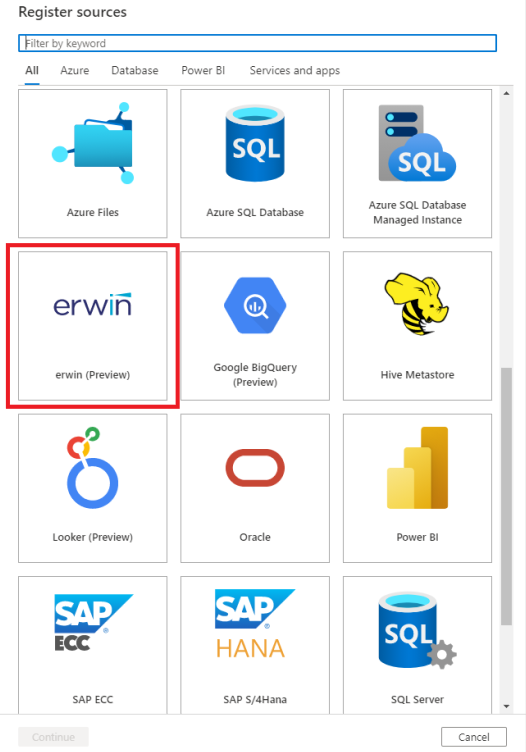
On the Register sources (erwin) screen, do the following:
Enter a Name that the data source will be listed within the Catalog.
Enter the erwin Mart Server name. This is the network host name used to connect to the erwin Mart server. For example, localhost
Enter the Port number used when connecting to erwin Mart. By default, this value is 18170.
Enter the Application name
Note
The above details can be found by navigating to your erwin Data Modeler. Select Mart -> Connect to see details related to server name, port and application name.
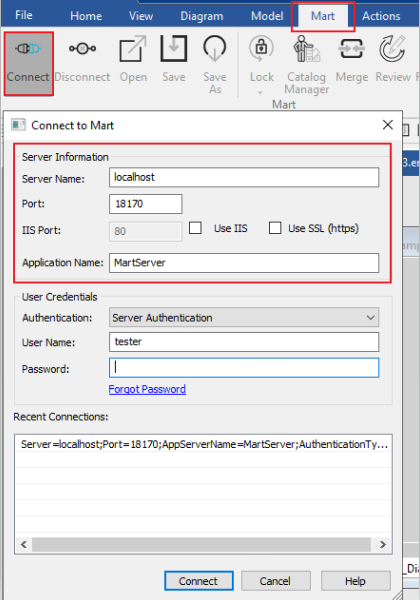
Select a collection from the list.
Finish to register the data source.
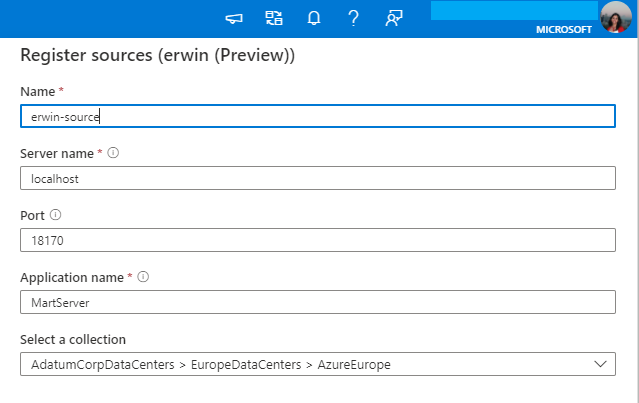
Scan
Follow the steps below to scan erwin Mart servers to automatically identify assets. For more information about scanning in general, see our introduction to scans and ingestion
Create and run scan
To create and run a new scan, do the following:
In the Management Center, select Integration runtimes. Make sure a self-hosted integration runtime is set up on the VM where erwin Mart instance is running. If it isn't set up, use the steps mentioned here to set up a self-hosted integration runtime.
Navigate to Sources.
Select the registered erwin Mart.
Select + New scan.
Provide the below details:
Name: The name of the scan
Connect via integration runtime: Select the configured self-hosted integration runtime.
Server name, Port and Application name are auto populated based on the values entered during registration.
Credential: Select the credential configured to connect to your erwin Mart server. While creating a credential, make sure to:
- Select Basic Authentication as the Authentication method
- Provide your erwin Mart server's username in the User name field.
- Save your user password for server authentication in the key vault's secret.
To understand more on credentials, refer to the link here.
Use Internet Information Services (IIS) - Select True or False to notify if Microsoft Internet Information Services (IIS) must be used when connecting to the erwin Mart server. By default this value is set to False.
Use Secure Sockets Layer (SSL) - Select True or False to Notify if Secure Sockets Layer (SSL) must be used when connecting to the erwin Mart server. By default, this value is set to False.
Note
This parameter is only applicable for erwin Mart version 9.1 or later.
Models - Scope your scan by providing a semicolon separated list of erwin model locator strings. For example, mart://Mart/Samples/eMovies;mart://Mart/Erwin_Tutorial/AP_Physical
Maximum memory available: Maximum memory (in GB) available on customer's VM to be used by scanning processes. This is dependent on the size of erwin Mart to be scanned.
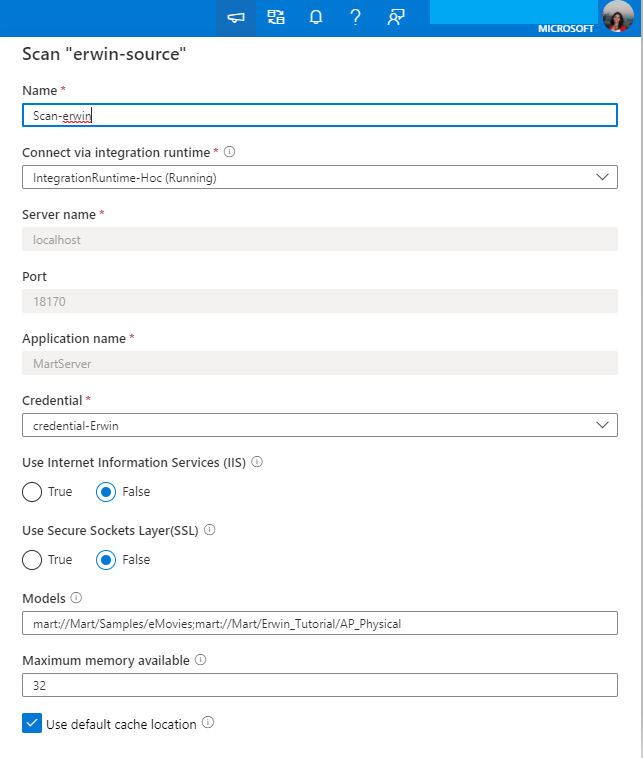
Select Test connection.
Select Continue.
Choose your scan trigger. You can set up a schedule or ran the scan once.
Review your scan and select Save and Run.
View your scans and scan runs
To view existing scans:
- Go to the Microsoft Purview portal. On the left pane, select Data map.
- Select the data source. You can view a list of existing scans on that data source under Recent scans, or you can view all scans on the Scans tab.
- Select the scan that has results you want to view. The pane shows you all the previous scan runs, along with the status and metrics for each scan run.
- Select the run ID to check the scan run details.
Manage your scans
To edit, cancel, or delete a scan:
Go to the Microsoft Purview portal. On the left pane, select Data Map.
Select the data source. You can view a list of existing scans on that data source under Recent scans, or you can view all scans on the Scans tab.
Select the scan that you want to manage. You can then:
- Edit the scan by selecting Edit scan.
- Cancel an in-progress scan by selecting Cancel scan run.
- Delete your scan by selecting Delete scan.
Note
- Deleting your scan does not delete catalog assets created from previous scans.
Lineage
After scanning your erwin source, you can browse data catalog or search data catalog to view the asset details.
Go to the asset -> lineage tab, you can see the asset relationship when applicable. Refer to the supported capabilities section on the supported erwin lineage scenarios. For more information about lineage in general, see data lineage and lineage user guide.
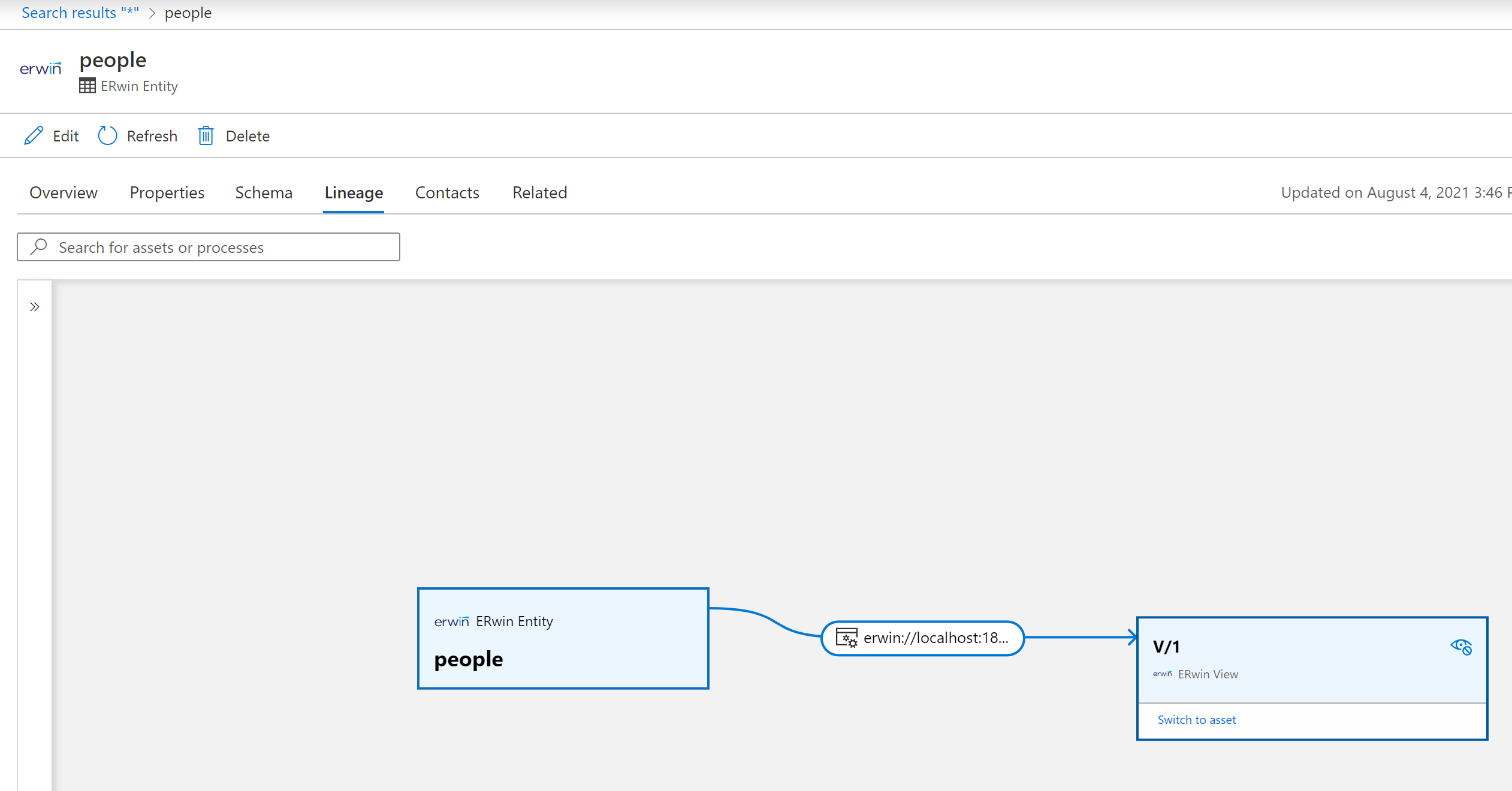
Next steps
Now that you've registered your source, follow the below guides to learn more about Microsoft Purview and your data.
Feedback
Coming soon: Throughout 2024 we will be phasing out GitHub Issues as the feedback mechanism for content and replacing it with a new feedback system. For more information see: https://aka.ms/ContentUserFeedback.
Submit and view feedback for